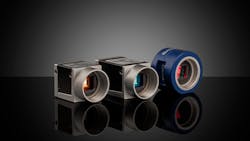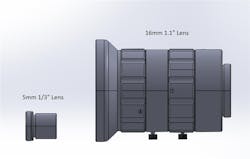An Uncertain Future for the Marriage of Lenses and Cameras
Nick Sischka
If there is only one constant in the world of machine vision, it is that resolution will always increase over time. Everything else may be up for debate, but it is quite rare (for lack of courage to write “has never happened”) for a sensor or camera company to unveil a new product and talk about how low the resolution is and how that is a great thing. Increasingly, resolutions seem to be running away at exponential speeds: 9 and 12 MPixels, the high resolutions of the ancient past of just a couple years ago, has given way to 120 MPixel, 150 MPixel, and 250 MPixel sensors (Figure 1). Although these sensors certainly are not used by the majority of machine vision systems yet, the trends nevertheless indicate that the resolution race does not show any signs of slowing down anytime soon.
One of the major barriers to these larger resolution sensors catching on to the mainstream is the lack of proper optics that can pair with these sensors. There are two primary reasons why optics will not pair with a sensor:
- Either the resolution of the optics is not high enough.
- The lens simply does not get light to the corners of the sensor and the corners of the image are dark.
While the first issue is largely application dependent, there tends to be a misunderstanding within the machine vision industry that lenses are not suitable for a camera unless the lens has a better resolution than the Nyquist limitation of the sensor, or its theoretical resolution limit defined as twice the pixel size. This idea is categorically false. Imaging at the Nyquist frequency is dubious at best and should only be used in tightly controlled circumstances, though this article will not dive into detail about those reasons.
The second issue is much more difficult to get around; if a lens will not get enough light to the corners of the sensor because the sensor is too large, then the pixels are doing nothing but adding extra expense and useless data to a system. While lenses that are designed for smaller sensors can be used on larger ones in certain circumstances (e.g. imaging a circular object like a bottle-top), in general if a larger sensor has been purchased, a proper lens designed to match that sensor size should be used as well. The unfortunate fact in this case is that higher resolution sensors tend to be larger in size than lower resolution sensors, which is why this illumination problem exists.
In theory, fixing the problem of not enough light in the corner of an image is easy. A larger lens needs to be designed that can accommodate the larger sensor (for the sake of discussion in this article, the assumption has been made that designing larger optics does not come with its own list of inherent caveats). This trend is quite visible throughout optics/cameras, whether the industrial space or the consumer space is being observed. Figure 2 shows an M12 lens designed for a sensor that has a diagonal of only 6 mm next to a C-mount lens that covers a sensor that is nearly three times as large, 17.6 mm. While M12 and C-mount lenses have been dominant in machine vision for most of its existence, the trend of increasing sensor sizes limits these mount options in the future.
Indeed, new lenses and cameras have been coming out in the market over the last few years with the TFL mount (M35 × 0.75 mm threading), which is suitable for sensors that are between 1.1 in. (~18 mm in diagonal) and APS-C (~30 mm in diagonal). This additional mount standard allows for lenses to grow and fill up these larger sensors, and although the standard itself is not new, having TFL-mount lenses and cameras available is. The development of these lenses with the TFL mount was a direct byproduct of larger sensors being developed and designed into larger cameras. While C-mount will absolutely remain dominant for the foreseeable future, especially with sensor companies figuring out ways to allow for steeper chief ray angle (CRA) acceptance, TFL will likely become more popular over time. It is worth mentioning, however, that a few years ago there existed a chicken and egg dilemma with TFL lenses/cameras. Since no cameras existed, no lenses existed, and vice versa!
As mentioned above, the rough limit for a sensor diagonal for TFL mount lenses is in the neighborhood of 30 mm, and there are already many sensors in the industrial space that are larger than that. While the optomechanical reasons to avoid F-mount are numerous and will not be covered here, the next logical jump is to a TFL-II (M48 × 0.75 mm) mount. It is a valid question to ask why M42 was skipped. The primary reason for not including M42 is because it is a prime example of how good intentions can go horribly wrong when it comes to a lack of standardization across the industry. Several camera companies make mounts that are designated as M42 mounts, which seems great at first. However, since there is no M42 mount “standard”, it has led to many different camera and lens companies making several different types of M42 mounts, which can make lens/camera selection incredibly confusing. For example, Edmund Optics carries lenses that are the exact same lens, both are M42, and yet they are not compatible with the same cameras, as their flange distances are different to match with the different M42 mounts that exist from the different camera manufacturers. Since camera companies usually make F-mount adapters for their M42 mount cameras, it is often easier to use the adapter since everyone’s F-mount lenses are the same. This adds additional parts and cost to the system and could mean that the ideal lens cannot be used for the application.
M42 is a cautionary tale for what can happen when standards are under-used in the imaging industry. Unfortunately, as larger sensors continue to be developed that push beyond existing standards, there is the possibility for this to happen again. The Japan Industrial Imaging Association (JIIA) has several different mounting standards that it specifies in its document, “LE-002-2018” for different imager sizes, although the standards for sensors larger than a full frame are relatively undeveloped (the standard hasn’t been updated since 2018). This is one of many factors that has led to camera companies designing and developing cameras with relatively random mounts with the thought that any adapter can be developed depending on what the lens companies decide to design. This is not a customer-friendly way to go about product development, but there is not much of a choice at the moment.
Lens companies and camera companies need to work together to develop new mounting standards for lenses and cameras for the larger sensors that are already here and for those coming down the road. Continuing product development in a vacuum, separated from each other, will create more and more problems; higher resolutions require tighter sensor placement tolerances and different optical design techniques that require a discussion between both developers in order to unlock the performance potential of the newer sensors.

